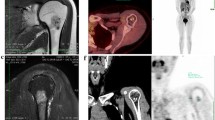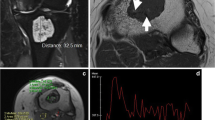Abstract
Introduction
Discriminating among benign chondroid tumors, low-grade chondrosarcomas, and grade 2/3 chondrosarcomas is frequently difficult with standard imaging modalities. We systematically reviewed the literature to determine the performance of PET-CT in making this distinction.
Methods
A systematic review was performed identifying 811 PubMed- and Embase-indexed articles containing combinations of “chondrosarcoma,” “enchondroma,” “chondroid,” “cartilage” and “PET/CT,” “PET,” “positron.” Eight articles including 166 lesions were included. Age, gender, tumor size, histologic grade, and SUVmax values were extracted for individual lesions when possible and otherwise recorded as aggregated data. Comparisons in SUVmax among benign, low-grade, and intermediate-/high-grade chondroid neoplasms were made.
Results
Individual SUVs were available for 101 lesions; 65 additional lesions were reported as aggregated data. There were 101 malignant and 65 benign tumors. Benign tumors were seen more frequently in females (p = 0.04, Fischer’s exact test), but malignancy was not associated with age or lesion size. SUVmax was lower for benign (1.6 ± 0.7) than malignant tumors (4.4 ± 2.5) (p < 0.0001, t-test). SUVmax was lower for grade 0/1 (2.0 ± 0.7) than grade 2/3 (6.0 ± 3.2) (p < 0.0001, t-test). Increasing SUVmax correlated with higher grade chondroid tumors (Spearman’s rank, ρ = 0.78). SUVmax ≥4.4 was 99% specific for grade 2/3 chondrosarcoma.
Conclusions
SUVmax correlates with histologic grade in intraosseous chondroid neoplasms; very low SUVmax supports a diagnosis of benign tumor, while elevated SUVmax is suggestive of higher grade chondrosarcoma.



Similar content being viewed by others
References
Logie CI, Walker EA, Forsberg JA, Potter BK, Murphey MD. Chondrosarcoma: a diagnostic imager’s guide to decision making and patient management. Semin Musculoskelet Radiol. 2013;17(2):101–15.
Murphey MD, Walker EA, Wilson AJ, Kransdorf MJ, Temple HT, Gannon FH. From the archives of the AFIP: imaging of primary chondrosarcoma: radiologic-pathologic correlation. Radiographics. 2003;23(5):1245–78.
Choi B-B, Jee W-H, Sunwoo H-J, Cho J-H, Kim J-Y, Chun K-A, et al. MR differentiation of low-grade chondrosarcoma from enchondroma. Clin Imaging. 2013;37(3):542–7.
Jennings R, Riley N, Rose B, Rossi R, Skinner JA, Cannon SR, et al. An evaluation of the diagnostic accuracy of the grade of preoperative biopsy compared to surgical excision in chondrosarcoma of the long bones. Int J Surg Oncol. 2010;2010:270195.
Roitman PD, Farfalli GL, Ayerza MA, Múscolo DL, Milano FE, Aponte-Tinao LA. Is needle biopsy clinically useful in preoperative grading of central chondrosarcoma of the pelvis and long bones? Clin Orthop. 2016.
Feldman F, Van Heertum R, Saxena C, Parisien M. 18FDG-PET applications for cartilage neoplasms. Skelet Radiol. 2005;34(7):367–74.
Costelloe CM, Chuang HH, Chasen BA, Pan T, Fox PS, Bassett RL, et al. Bone windows for distinguishing malignant from benign primary bone tumors on FDG PET/CT. J Cancer. 2013;4(7):524–30.
Jesus-Garcia R, Osawa A, Filippi RZ, Viola DCM, Korukian M, de Carvalho Campos Neto G, et al. Is PET-CT an accurate method for the differential diagnosis between chondroma and chondrosarcoma? SpringerPlus. 2016;5:236.
Cleven AHG, Höcker S, Briaire-de Bruijn I, Szuhai K, Cleton-Jansen A-M, Bovée JVMG. Mutation analysis of H3F3A and H3F3B as a diagnostic tool for Giant cell tumor of bone and Chondroblastoma. Am J Surg Pathol. 2015;39(11):1576–83.
Romeo S, Eyden B, Prins FA, Briaire-de Bruijn IH, Taminiau AHM, Hogendoorn PCW. TGF-beta1 drives partial myofibroblastic differentiation in chondromyxoid fibroma of bone. J Pathol. 2006;208(1):26–34.
de Silva MVC, Reid R. Chondroblastoma: varied histologic appearance, potential diagnostic pitfalls, and clinicopathologic features associated with local recurrence. Ann Diagn Pathol. 2003;7(4):205–13.
Shin D-S, Shon O-J, Han D-S, Choi J-H, Chun K-A, Cho I-H. The clinical efficacy of (18)F-FDG-PET/CT in benign and malignant musculoskeletal tumors. Ann Nucl med. 2008;22(7):603–9.
Brenner W, Conrad EU, Eary JF. FDG PET imaging for grading and prediction of outcome in chondrosarcoma patients. Eur J Nucl med Mol Imaging. 2004;31(2):189–95.
Lee FY-I, Yu J, Chang S-S, Fawwaz R, Parisien MV. Diagnostic value and limitations of fluorine-18 fluorodeoxyglucose positron emission tomography for cartilaginous tumors of bone. J Bone Joint Surg am. 2004;86–A(12):2677–85.
Purandare NC, Rangarajan V, Agarwal M, Sharma AR, Shah S, Arora A, et al. Integrated PET/CT in evaluating sarcomatous transformation in osteochondromas. Clin Nucl med. 2009;34(6):350–4.
Strobel K, Exner UE, Stumpe KDM, Hany TF, Bode B, Mende K, et al. The additional value of CT images interpretation in the differential diagnosis of benign vs. malignant primary bone lesions with 18F-FDG-PET/CT. Eur J Nucl med Mol Imaging. 2008;35(11):2000–8.
Dierselhuis EF, Gerbers JG, Ploegmakers JJW, Stevens M, Suurmeijer AJH, Jutte PC. Local treatment with adjuvant therapy for central atypical cartilaginous tumors in the long bones: analysis of outcome and complications in one hundred and eight patients with a minimum follow-up of two years. J Bone Joint Surg am. 2016;98(4):303–13.
Douis H, Singh L, Saifuddin A. MRI differentiation of low-grade from high-grade appendicular chondrosarcoma. Eur Radiol. 2014;24(1):232–40.
Crim J, Schmidt R, Layfield L, Hanrahan C, Manaster BJ. Can imaging criteria distinguish enchondroma from grade 1 chondrosarcoma? Eur J Radiol. 2015;84(11):2222–30.
Arsos G, Venizelos I, Karatzas N, Koukoulidis A, Karakatsanis C. Low-grade chondrosarcomas: a difficult target for radionuclide imaging. Case report and review of the literature. Eur J Radiol. 2002;43(1):66–72.
Kaya GC, Demir Y, Ozkal S, Sengoz T, Manisali M, Baran O, et al. Tumor grade-related thallium-201 uptake in chondrosarcomas. Ann Nucl med. 2010;24(4):279–86.
Ferrer-Santacreu EM, Ortiz-Cruz EJ, Díaz-Almirón M, Pozo Kreilinger JJ. Enchondroma versus chondrosarcoma in long bones of appendicular skeleton: clinical and radiological criteria—a follow-up. J Oncol. 2016;2016:8262079.
Liu F, Zhang Q, Zhu D, Li Z, Li J, Wang B, et al. Performance of positron emission tomography and positron emission tomography/computed tomography using fluorine-18-fluorodeoxyglucose for the diagnosis, staging, and recurrence assessment of bone sarcoma. Medicine (Baltimore) [Internet]. 2015 11 [cited 2016 Nov 30];94(36). Available from: http://www.ncbi.nlm.nih.gov/pmc/articles/PMC4616630/
Tian R, Su M, Tian Y, Li F, Li L, Kuang A, et al. Dual-time point PET/CT with F-18 FDG for the differentiation of malignant and benign bone lesions. Skelet Radiol. 2009;38(5):451–8.
Sheikhbahaei S, Marcus C, Hafezi-Nejad N, Taghipour M, Subramaniam RM. Value of FDG PET/CT in patient management and outcome of skeletal and soft tissue sarcomas. PET Clin. 2015;10(3):375–93.
Kinahan PE, Fletcher JW. Positron emission tomography-computed tomography standardized uptake values in clinical practice and assessing response to therapy. Semin Ultrasound CT MR. 2010;31(6):496–505.
Andersen KF, Fuglo HM, Rasmussen SH, Petersen MM, Loft A. Volume-based F-18 FDG PET/CT imaging markers provide supplemental prognostic information to histologic grading in patients with high-grade bone or soft tissue sarcoma. Medicine (Baltimore). 2015;94(51):e2319.
Author information
Authors and Affiliations
Corresponding author
Ethics declarations
Conflict of interest
The authors declare that they have no conflict of interest.
Rights and permissions
About this article
Cite this article
Subhawong, T.K., Winn, A., Shemesh, S.S. et al. F-18 FDG PET differentiation of benign from malignant chondroid neoplasms: a systematic review of the literature. Skeletal Radiol 46, 1233–1239 (2017). https://doi.org/10.1007/s00256-017-2685-7
Received:
Revised:
Accepted:
Published:
Issue Date:
DOI: https://doi.org/10.1007/s00256-017-2685-7




